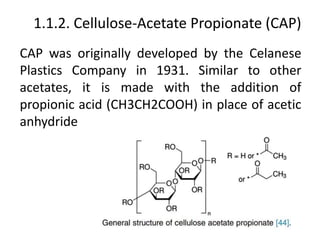This document discusses types of biodegradable polymers. It describes several categories of biodegradable polymers including starch-based polymers, cellulose-based polymers, bacterial polyesters, and synthetic biodegradable polymers. Starch-based polymers include thermoplastic starch, starch blended with synthetic aliphatic polyesters, starch blended with PBS or PBSA, and starch blended with PVOH. Cellulose-based polymers include cellulose esters and celluloid. Examples of bacterial polyesters discussed are PHA, PHB, PHB/HV, and PCL. The document also provides details on popular synthetic biodegradable polymers including PLA, PCL, PGA, P







































































